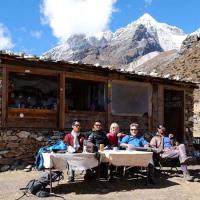

Email Us
contact@destinationhimalayatreks.com
Viber/Whats App 
+977-98510 16814 (Min Gurung)+977-98511 46814 (Tara Rana)
Kanchenjunga Circuit Trek 19 Days
$1850 per Pax
Overview
The Kanchenjunga Circuit trek is a mind blowing adventure in the Himalayas of Nepal which explores both Base Camps North and South of the third highest mountain in the world Kanchenjunga 8586 meter and the second highest mountain in Nepal after first Highest Mt. Everest.
Kanchenjunga trekking takes you through the remote villages, lush forests and stunning mountain passes where the landscape is filled with rivers, glacial lakes, waterfalls and green meadows. The Yalung Glacier offering trekkers challenging experience for nature lovers and adventure seekers with great enthusiasm
This Kanchenjunga circuit offers stunning views of not only Kanchenjunga but also other peaks like Yalung Kang, Kabru and Jannu. Kanchenjunga situates near the border with Sikkim-India, a tiny Himalayan state in the north east India. Kanchenjunga was known for the world highest peak until mid-1800. The area was closed to trekkers until mid-1980 whereas in the present days, the region is protected by Kanchenjunga Conservation Area project to get through the trek restricted area entry permit is required which provides by Ministry of Nepal Immigration Department.
In addition to the main peak of Kanchenjunga itself, there are four major subsidiary summits as well exceeding 8000 meter, the most important being Kanchenjunga west also known as Yalung Kang (8505 m) which is one of the prominent peaks in the region, also found in the same area are approximately 20 peaks exceeding 7000 meters, the highest being Kambachen (7903 m) that offers stunning views for mountaineers, Janu (7710 m), Jongsong (7483 m) , Tent peak (7365m), Kabru (7353 m) and lastly the Twins (7350 m).
Kanchenjunga Circuit trekking is a complete package of adventure, remoteness, culture and religion of locals. This itinerary includes Kanchenjunga South Base Camp, Sele La Pass, Kanchenjunga North base Camp, an adventure day hiking from Lonak to Kanchenjunga Base Camp would be life time memory.
This off the beaten Kanchnjunga trekking is truly noteworthy which offers trekkers a treasured experience where trekkers get right into the heart of the remote, off the beaten trek route, Himalaya mountains and valleys.
Please click the route map video https://www.relive.cc/view/r10003980959
- Trek through terraced fields, pristine pine, and bamboo forests, lush grazing pastures, glacial lakes, the prominent snow-clad massif of Kanchenjunga
- Amazing time hiking through the diverse flora and fauna, Wonderful scenery of the flowery forest of Rhododendron, Lilies, Primula, and Orchards
- Ethnic Culture and lifestyle of Rai and Limbu communities, warmth hospitality
- Exploration of Gunsa village, Crossing the Sele La Pass
- Recognized as one of the 200 global eco-regions by the World Wildlife Fund (WWF)
- Excursion Kanchenjunga North Base Camp
- Relish the panoramic view of– Frey Peak, Koktang, Kabru Peak, Chandra Peak, and the Kabru Dome, Mt. Everest, Mt. Lhotse, Mt. Makalu, Mt. Jannu, Mera Peak, Rathong
Short Itinerary
Day 01: Arrival Kathmandu and transfer to hotel
Day 02: guided sightseeing tour, overnight hotel
Day 03: Flight to Bhadrapur and drive with bus or jeep to Taplejung, 1820m
Day 04: Taplejung to Sekathum, 1650m
Day 05: Sekathumto Amjilosa, 2500m
Day 06: Amjilosa to Gyabla, 2750m
Day 07: Gyabla to Ghunsa, 3425m
Day 08: Ghunsa to Khambachen, 4150m
Day 09: Acclimatization
Day 10: Khambachen to Lhonak, 4790m
Day 11: Excursion Kanchenjunga North Base Camp (Pang Pema), 5145m and trek back to Lhonak
Day 12: Lhonak to Ghunsa, 3425m
Day 13: Ghunsa to Sele La Base Camp, 4250m
Day 14: Sele La Base Camp to Tseram, 3870m
Day 15: Tseram to Ramche and hike to Oktang (Yalung South Base Camp) View Point, 4740m and back to Ramche-Tseram
Day 16: Tseram to Tortong, 2980m
Day 17: Tortong to Yamphudin, 1690m
Day 18: Yamphudin to Kanyam, 1210m and continue drive to Bhadrapur
Day 19: Flight from Bhadrapur to Kathmandu, overnight hotel
Includes
- All private land transportation as required for trek and airport pick-up/drop
- Domestic flight tickets as indicated
- All accommodation as above program
- Special permit, national park permit, trekking permit
- Well equipped, informative and flexible English (or related language) speaking guide
- Necessary porters (2 people get 1 porter in group)
- All allowances for guide and porters
- Emergency evacuation fee if in case needed
Excludes
- Personal gears and expenses
- Emergency evacuation fees if in case...
- Tip to guide and entire support crews
Detail Itinerary
-
Kanchenjunga Trek All Information
Accommodation
Accommodations in the Kanchenjunga Treks are in teahouses/lodges, very basic lodges with local foods . The trek duration is of 21 days and Taplejung is the starting and ending point. Kanchenjunga region is remote and the numbers of trekkers are fewer compared to other trek regions of Nepal. Therefore, the numbers of teahouses/lodges are fewer, and at far distances from each other. In some places, accommodation is at tented camps. The teahouses/lodges have basic but comfortable facilities. Since there are fewer teahouses in the Kanchenjunga region, sharing of rooms and toilets must be done. The toilets are of eastern style and outside the teahouse. Since this is trekking in the mountains, some adjustments must be made.
Meals
3 courses meals (Breakfast, Lunch, and Dinner) are provided during the trekking. The meals are healthy and hygienic. The meals are simple and the main dish is Nepali Dal Bhat with vegetables and pickles. There won’t be varieties of dishes but foods with high nutritional values to keep the body energetic and fit are served. Besides Dal-Bhat, noodles, soups, eggs, bread, hot tea, ginger tea, coffee, porridge, fresh seasonal fruits, vegetables, etc. are served. The professional chef accompanies the trek and prepares food in the camps.
Drinking water
In the mountains, natural spring water is the source of drinking water. The fresh and clean water directly from the Himalayas tastes great. Carry a durable water bottle to fill water from the taps or at teahouses. The boil water paying extra charges can get from teahouses as well. It is always good to carry water purification tablets or Steripen to purify the water.
Communication
Kanchenjunga is a remote region and as the altitude rises, it’s hard to get communication signals. The communication signal works at lower altitudes and at higher altitudes it may work sometimes and may not most of the time. The internet facility and phone communications can be used where the signal is strong. Electricity is available in most places. In some places, there are solar panels as well. For charging electronic gadgets, in some places, one must pay an additional charge. Thus, bring essential accessories such as solar power banks, charging cables, and extra batteries. No communication for some days is also good to stay away from a busy life peacefully.
Starting and Ending points
The Kanchenjunga Trek starts from Taplejung after 10 hours off road driving from Bhadrapur and ends in Kanyam.
Permits Required
Kanchenjunga Restricted Area Permit (RAP) and Kanchenjunga Conservation Area entry permits and TIMS are required for the Kanchenjunga trek. There must be 2 or more people will get Restricted permit and most join the agency to apply permit. No individual trekker can do this trekking.
Travel InsuranceTravel Insurance is essential while traveling. Travel insurance is most for Kanchenjunga Trek as the trek duration is longer. Only a few trekkers trek to this region which makes this region less crowded. It acts as a safety net while traveling/trekking far from the home. Get travel insurance from a trusted insurance company. The travel insurance must cover all medical emergencies, helicopter rescue, air ambulance, flight cancelations, loss/theft of luggage, personal expenses, cover repatriation, evacuations, and altitude sickness. Do carry a copy of your travel insurance and also send a copy to us. So that it would be easy for making the necessary arrangements in case of emergencies.
Best time to trek Kanchenjunga Trek
The suitable time to trek Kanchenjunga is during the summer and autumn seasons. The weather and sky are clear. The blossoming rhododendrons and awesome views make these seasons the best. Thus, early March to mid-May and October to late November is considered the best time to trek. Off-season trekking in Monsoon and Winter is available for professional trekkers. But, these seasons of trekking are very tough and at your risk, you can go for it. The winter season is extremely cold and camping is the only option making it very hard for the trekkers. Monsoon season is slippery and muddy and risk of accidents and injuries. We recommend you avoid these seasons but it is your personal choice to continue or avoid them.
Kanchenjunga Trek Difficulty
Kanchenjunga Trek is one of the longest treks having a duration of 24 days. The trek is difficult due to its duration, many ascend, and descend rugged terrains, and high altitudes. Pang Pema (5,143m) is the highest elevation during the trek. Since the region is remote, access to all sorts of facilities is difficult to find. Hence, trekking should commence with proper training and preparations and consulting the doctor. The trekkers must take some physical exercises before months of the Kanchenjunga Trek and be physically fit and in good health condition to accomplish the trek successfully. Some examples of physical exercises are swimming, cycling, running, day hiking, etc. The trek is tricky but the planned itinerary with proper rest day schedules helps to complete the trek on time and without worries.
Acclimatization and Altitude Sickness at Kanchenjunga Trek
Altitude sickness is common at higher altitudes in the mountains of Nepal. Kanchenjunga trek consists of several high altitudes. The acclimatization rest day is properly scheduled at Cheram (3870m) to adjust to the higher altitudes and prevent altitude sickness during the trek.
Symptoms of Altitude Sickness
Primary: Headache, nausea, gasping, appetite & sleep loss, dizziness, fatigue, vomiting
Extreme: primary symptoms and hallucinations & unconsciousnessPreventive Guidelines
- Immediately inform the guide
- Warm-up, and body stretch before the trekking journey
- Drink water and Hydrate yourself at regular intervals
- Frequent urination throughout the journey
- Ascend slowly and gradually
- Take plenty of rest and sleep
- Avoid salty foods, alcohol, and smoking
- Descend immediately when it’s difficult/uneasy
- Take medicine consulting a guide
Luggage limitation for Porter
The luggage limitation of the porter is an average of 20 to 24 kg. One porter carries the luggage of two trekkers. Hence, the luggage limitation per person is a maximum of 10 to 12 kg. The camping pack is up to 30-32 kg as few days are spent in a tented camp. The health of the porters is our high priority and all the arrangements are done on this basis.
Essential Documents: Passport, Travel Permits
Shoes: Pair of trekking shoes, Rubber sandals
Clothes: Windcheater jacket, Thermals, Insulating Down Jacket, Fleece, Long sleeve shirts, Gloves, Towels, Trekking pants, Trousers, Shorts, Socks, Gaiters
Accessories: Sunglasses, Hats/Caps, Sunscreen, Lip Balm, Metal water bottles, Pocket Knife, Solar chargers, Batteries, Torch, Sewing kit, Water Purifying solution/Steripen
Equipment: Warm Sleeping bags, Trekking poles, Duffel bag, Carabiners, Crampons, Tapes/Slings, a day pack
Medicine: First-Aid Kit, Altitude sickness medicines, Insect repellents
Rainy season: Waterproof clothes, boots, Raincoat, Anti-leech socks
Winter Season: Woolen clothing items (light)
Personal Hygiene Kit: Hand sanitizer, wet wipes, napkins, sachet shampoo, moisturizer, hand wash/soaps, toothbrush, toothpaste, comb/brush, and for ladies (tampons/sanitary pads/menstrual cups)
It is best to bring the clothes and essential equipment from your home from the provided checklist. Also, you can buy or rent equipment and clothes in Kathmandu. Don’t forget to carry extra 2-4 reusable bags to separate used/dirty and clean clothes.











